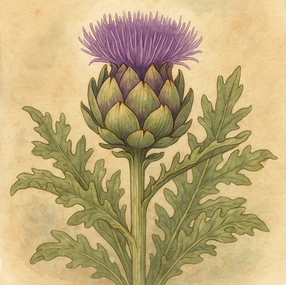
GROWING ARTICHOKES
Artichokes have long been prized as noble vegetables—once served at the tables of kings and beloved by herbalists for their protective spirit. In old tales, planting artichoke crowns beneath the waxing moon was thought to bring prosperity. The tightly wrapped buds were seen as little fortresses, keeping the magic of summer safe until dawn.
Cultivate artichokes, and you welcome a living legend into your garden—a plant that grows into a tower of edible mystery, with hearts that taste of both earth and enchantment.

HOW TO
-
Choose your crown’s resting place - Select a sunny, sheltered patch with rich, deeply turned soil. In autumn, prepare the bed by removing weeds and stones, and gently work in well-rotted compost or manure—enough to cradle your artichoke crowns in soft nourishment, setting the stage for their grand debut in spring.
-
Planting the crowns - When late winter’s frost begins to soften, plant your artichoke crowns about 45 cm (18 in) apart, with each crown nestled just below the soil line.
-
Cover them gently, firm the earth, and give them a tender watering—this marks the beginning of their slumber until they awaken with spring’s warm coaxing.
-
Patience is a gentle virtue - Artichokes are generous—but wise gardeners know: the first year is for growth, not harvest. Let the plants unfurl their silvery foliage and gather strength. In the second season, you may gather a few small artichokes, and by the third year, the crown may offer a bountiful harvest of full-sized globe-shaped wonders.
-
Harvesting the hearts - When the buds stand proud, tight, and plump—just before they stretch into blooms—snip them cleanly from the stalk, leaving a few inches of stem intact. This encourages fresh side shoots, and may surprise you with a second wave of tender buds.
-
Care through cycles - In summer’s warmth, feed with compost or a high-potash food to keep the hearts swelling and the foliage lush. In autumn, once the foliage begins to fade, chop it back and mulch the bed deeply with well-rotted compost or leaf mould. This gentle layer protects the crowns through the hush of winter, readying them for another season of green abundance.
View our tips and recipes on how to use.



